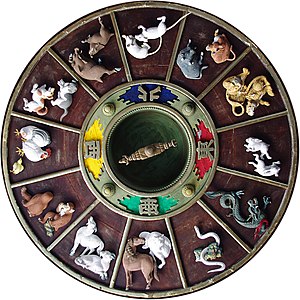Earthly Branches
| Earthly Branches | |||||||||||||||||
|---|---|---|---|---|---|---|---|---|---|---|---|---|---|---|---|---|---|
 | |||||||||||||||||
| Chinese name | |||||||||||||||||
| Chinese | 地支 | ||||||||||||||||
| |||||||||||||||||
| Vietnamese name | |||||||||||||||||
| Vietnamese alphabet | Địa Chi | ||||||||||||||||
| Chữ Hán | 地支 | ||||||||||||||||
| Korean name | |||||||||||||||||
| Hangul | 지지 | ||||||||||||||||
| Hanja | 地支 | ||||||||||||||||
| |||||||||||||||||
| Japanese name | |||||||||||||||||
| Kanji | 地支 | ||||||||||||||||
| Hiragana | ちし | ||||||||||||||||
| |||||||||||||||||
The Earthly Branches (or Terrestrial Branches) are a system of twelve ordered symbols used throughout East Asia. They are indigenous to China, and are themselves Chinese characters, corresponding to words with no concrete meaning other than the associated branch's ordinal position in the list. Cultural applications of the Branches include a dating system known as the sexagenary cycle, as well as astrology. They are associated with the ten Heavenly Stems in Chinese calendars, and in Taoist practice.
Overview[edit]
The twelve Earthly Branches are:
- 子
- 丑
- 寅
- 卯
- 辰
- 巳
- 午
- 未
- 申
- 酉
- 戌
- 亥
The branches each have specific names in languages of the Sinosphere—which include Chinese, Japanese, Korean, Vietnamese, and Mongolian. Branches are commonly used when counting in a manner similar to how letters are used according to their alphabetical ordering. In case of upper-case letters, the ⼝ 'MOUTH' radical may be added to the corresponding ordinal to denote an uppercase letter.[1] In addition to the calendar months, each branch has been associated with several distinct cultural categories, including animals and the hours of the day, with some regional variation.
History[edit]
The system of Earthly Branches was derived from observations of the planet Jupiter (歲星; Suìxīng; 'Year Star'), whose orbital period is roughly twelve Earth years long. Chinese astronomers divided the celestial circle into twelve sections to follow the orbit of Jupiter.
Jonathan Smith has proposed that the first meanings of the earthly branches, predating the Shang dynasty, were phases of the moon, with the Heavenly Stems at that point referring to divisions of the ecliptic. After being adopted as a calendar these would have lost their clear lunar reference, permitting their repurposing for Jupiter stations.[2]
The Earthly Branches are used with the Heavenly Stems in Chinese calendars, and in Taoist practice. Many Chinese calendrical systems have started the new year on the second new moon after the winter solstice. The Stems were tied to the ritual calendars of Chinese kings. Stem–branch combinations are a fairly new way to mark time; the ten Heavenly Stems provided names for the days of the week during the Shang. The Branches are at least as as old as the Stems, with archeological evidence suggesting they may actually be older.
Directions[edit]

Though Chinese has words for the four cardinal directions, Chinese sailors and astronomers preferred using the 12 directions of the Earthly Branches, analogous to the use of o'clock for directions by English-speaking pilots. Since twelve points were not enough for sailing, 12 midpoints were added. Instead of combining two adjacent direction names, they assigned new names: for the four diagonal directions, appropriate trigram names of I Ching were used. For the rest, Heavenly Stems 1–4 and 7–10 were used. According to the five elements theory, east is assigned to wood, and the Stems of wood are 甲 (jiǎ) and 乙 (yǐ). Thus, they were assigned clockwise to the two adjacent points of the east.
Mariners like Zheng He (fl. 1405–1433) used 48-point compasses. An additional midpoint was called by a combination of its two closest basic directions, such as 丙午 (bǐngwǔ; 172.5°), the midpoint between 丙 (bǐng; 165°) and 午 (wǔ; 180°).
References[edit]
Citations[edit]
- ^ [1] (pages 147 and 148)
- ^ Smith, Jonathan M. (2011). "The Di Zhi 地支 as Lunar Phases and Their Coordination with the Tian Gan 天干 as Ecliptic Asterisms in a China before Anyang". Early China. 33: 199–228. doi:10.1017/S0362502800000274. S2CID 132200641. Retrieved January 29, 2022.
Works cited[edit]
External links[edit]
- "Heavenly Stems and Earthly Branches". Hong Kong Observatory. Archived from the original on 2018-11-04. Retrieved 2018-11-04.
